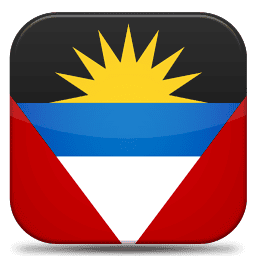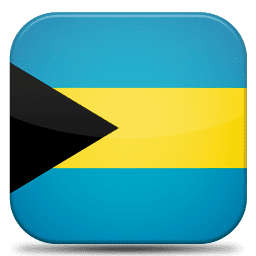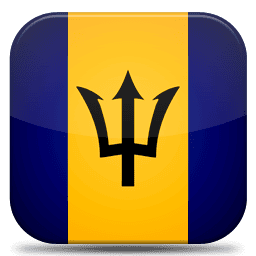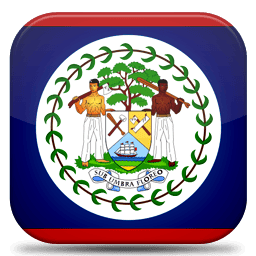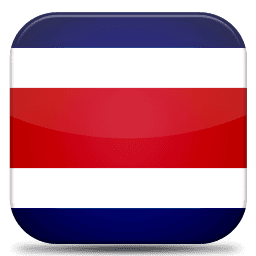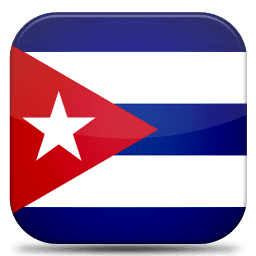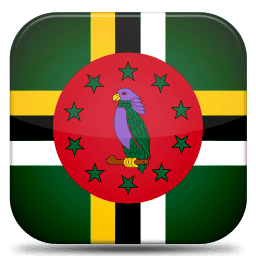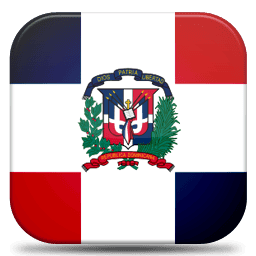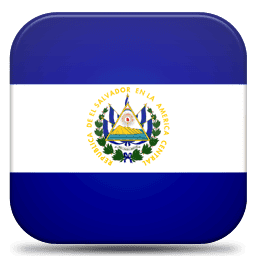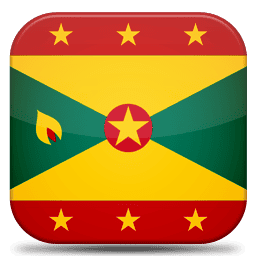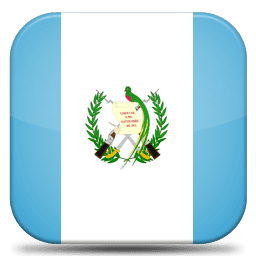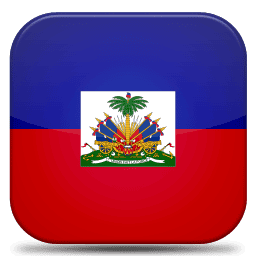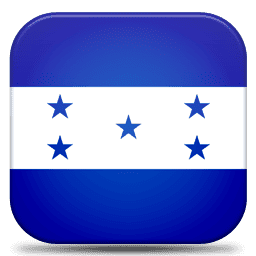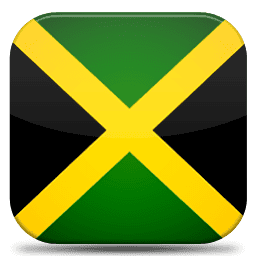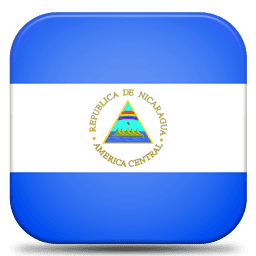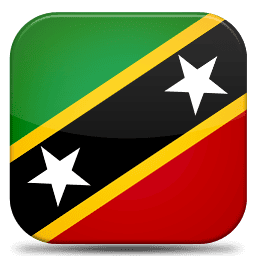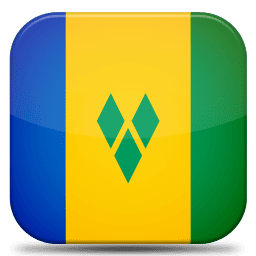Table of Contents
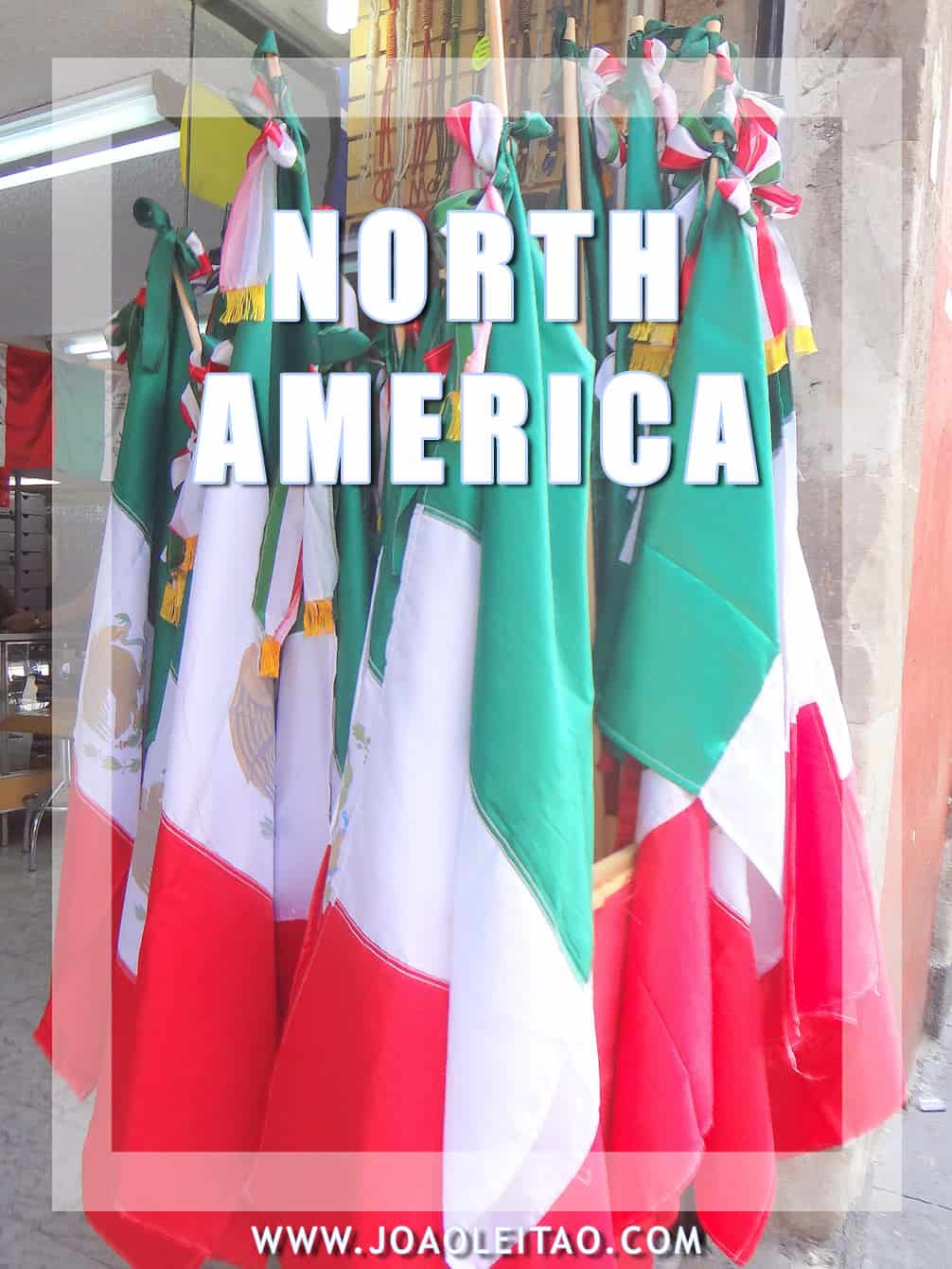
The North American flags represent the national identity of each country. Each color has a meaning in the history of nations. The flags from America vary on color and meaning. On this page, I list all flags of North America, Central America, and their colors.
Copyright: I own the copyright usage of these images. You cannot use the text or image without permission.
North, Central America & Caribbean National Flags
Alphabetic order

Antigua and Barbuda 
Bahamas 
Barbados 
Belize 
Canada 
Costa Rica 
Cuba 
Dominica 
Dominican Republic 
El Salvador 
Grenada 
Guatemala 
Haiti 
Honduras 
Jamaica 
Mexico 
Nicaragua 
Panama 
Saint Kitts and Nevis 
Saint Lucia 
Saint Vincent and the Grenadines 
USA
Flags of North America
Flag of Canada
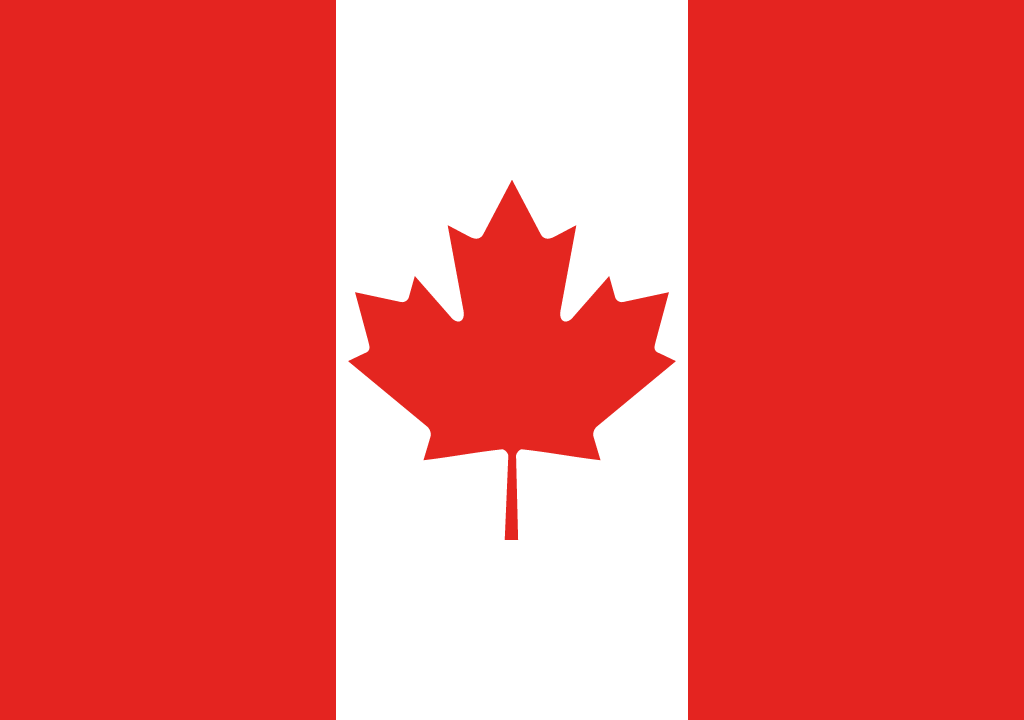
2 colors: red, white.
Meaning of the flag of Canada: Canada’s flag contains the national colors, part of the country’s history. Red was taken from the Saint George’s Cross; white is from the French royal emblem. The maple leaf symbolizes the national tree of Canada.
Curiosities about the Flag of Canada
- The flag of Canada has three stripes, one white in the middle and two red on each side. There’s a leaf of a maple tree in the center, Canada’s national tree.
- It’s a relatively recent flag. It began in 1964 when Prime Minister Lester B. Pearson decided it was time the country had a national flag (they used the United Kingdom flag until then) and created a committee to create one. Three flag proposals were discussed and the current version won the debate. Dr. George Stanley created it in 1965, who, inspired by the flag of the Royal Military College of Canada, tried to fit all the country’s complexity into a simple concept.
- The leaf represents Canada’s native people, who for centuries had a close connection with maple and its syrup, still a traditional product in the country these days.
- The maple leaf had been used as a national symbol before by Olympic athletes and the Canadian military fighting in both World Wars.
- The colors, red and white, represent the historical relations with the United Kingdom since those are the colors of England.
- The flag was hoisted officially for the first time on 15 February 1965, a date the Canadians celebrate as Flag’s Day.
Flag of USA
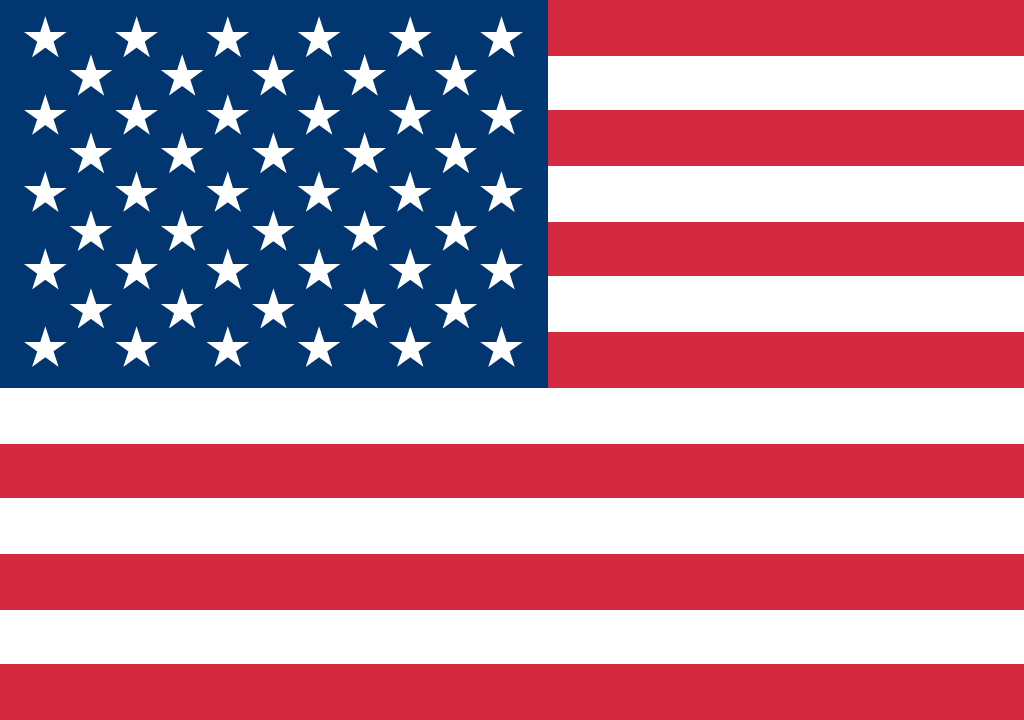
3 colors: blue, white, red.
Meaning of the flag of USA: The colors of the flag, “The Stars and Stripes”, are the same as in the Great Seal of the USA. White signifies purity and innocence; red is for hardiness and valor; blue is the color of the Chief and means vigilance, perseverance, and justice. As for the stars, they symbolize the heavens and the divine goal to which man has aspired from time immemorial. There are 50 stars to represent the 50 states of the United States of America. The stripes, symbolizing rays of light coming from the sun, are 13 stripes, to represent the 13 British colonies that declared independence from the Kingdom of Great Britain.
Curiosities about the Flag of the United States of America
- The flag of the United States of America is perhaps one of the most famous in the world.
- It has 13 horizontal stripes that represent the territories that opposed England, and a blue square in the top left corner with 50 white five-point stars, one for each state.
- The number of stars has been adjusted over the years as the country grew. The most recent star was added in 1960 when Hawaii became a state official.
- The first historical reference to the flag dates back to 1777 and it was probably created by Congressman Francis Hopkinson, inspired by the flag of a group of activists, the Sons of Liberty, who organized a protest against the English customs.
- At that time, there were as many stars as there are stripes, 13, laid in a circle.
- It’s believed the choice of colors is purely aesthetical, without any specific meaning.
Flags of Central America
Flag of Belize
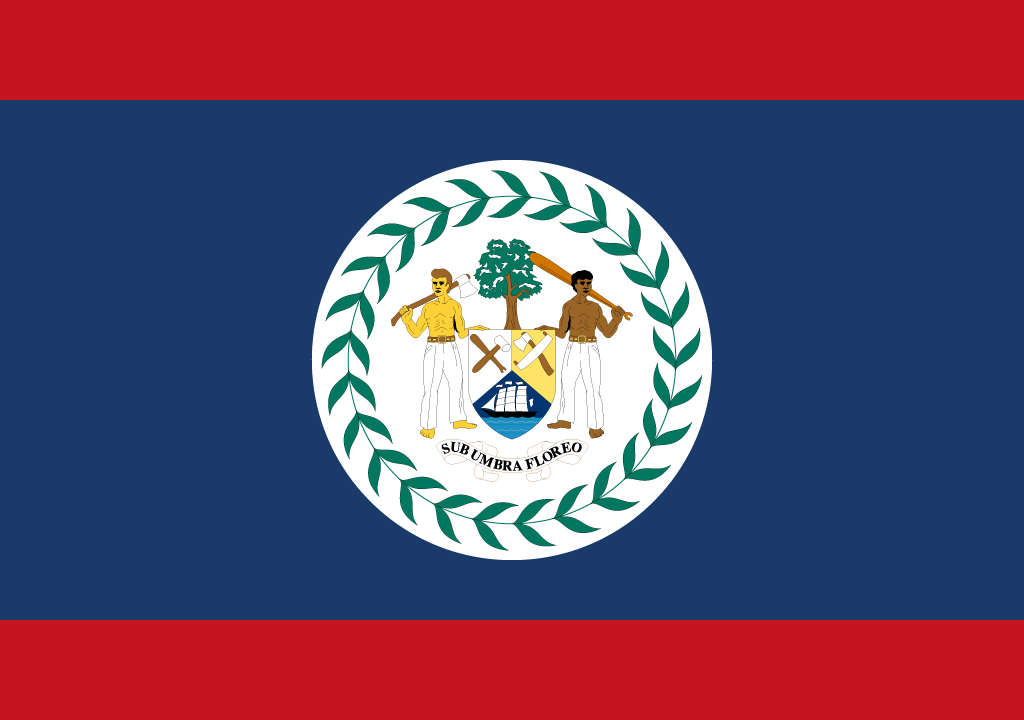
3 colors: red, blue, white.
Meaning of the flag of Belize: The flag of Belize has twelve colors, more than any other national flag, but three are dominant. The colors represent the national parties of Belize, blue for the People’s United Party, red for the opposition party. Two woodcutters hold the shield with the coat of arms in a white circle in the center. One of the men carries an axe and the other a wooden oar. Behind them is a mahogany tree, very important to the economy of early Belize. The shield is divided into three sections containing tools for two important industries in Belize: woodcutting and boat-building. The banner has the national motto of the country “Sub Umbra Floreo”, which means “Under the Shade I Flourish”. Also present around all the images there is a chain of twenty-five leaves.
Curiosities about the Flag of Belize
- The flag of Belize is mainly dark blue, with a considerably large national coat of arms in the center. There are two thin red stripes along with the flag, in the top and the bottom.
- There isn’t an official interpretation for the flag’s colors, but it might not be a coincidence that those are the same colors of the country’s two main political parties: People’s United Party (PUP) and United Democratic Party (Belize) (UDP).
- The flag was created around 1950, when the fight for independence started in Belize, ironically based in the colonial flag of that time. That original flag resembles the current one, except for the two red stripes that were added after the independence.
- The coat of arms shows two men, a mixed-race one and a black one, under a mahogany tree, one of them holding a paddle and the other one holding an ax. Under them, the motto in Latin “Sub umbra floreo,” which translates into “under the shade I flourish,” and that can be related to the growth of the sensation of a nation during the colonial times.
- The final version of the flag, as it has been used since the country’s independence in 1981, was chosen in a public competition. The winning flag had, initially, a red frame around the flag, later changed to the two stripes you see today in the flag of Belize.
Flag of Costa Rica
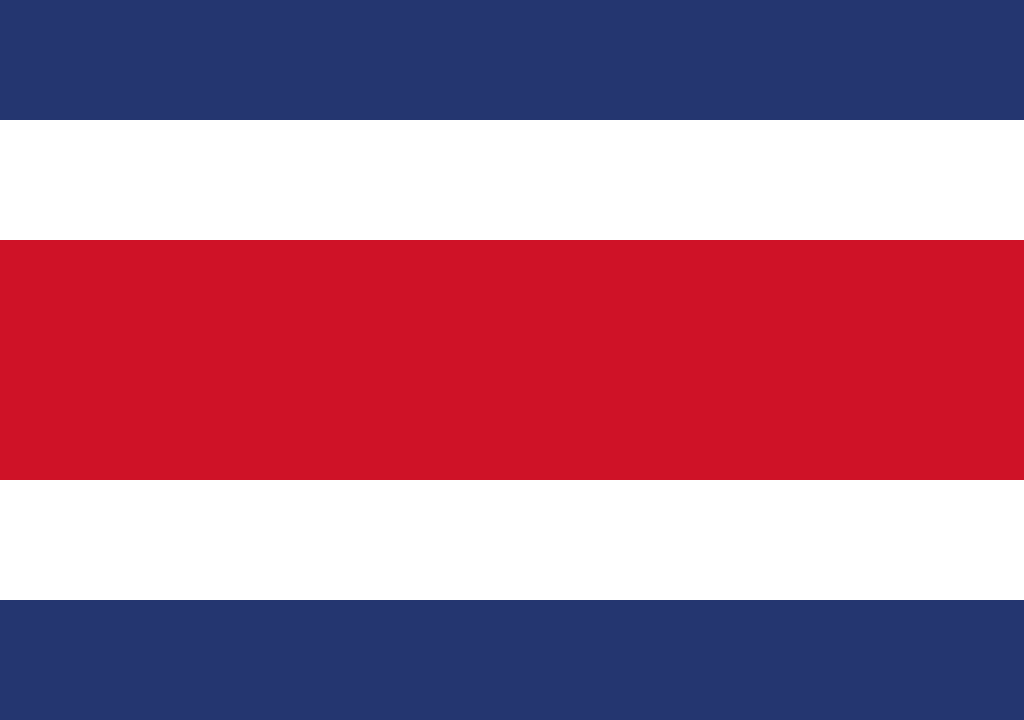
3 colors: blue, white, red.
Meaning of the flag of Costa Rica: The colors of the Costa Rica Flag are the same as in the French Tricolore. Blue symbolizes clear skies, the growth and development opportunities in Costa Rica, free and independent thinking, spirituality and perseverance; white represents joy and happiness, the power of wisdom, the initiative of the people and peace; red stands for the warmth and hospitality of the people, the blood of their sacrifices and the vibrancy of the land.
Curiosities about the Flag of Costa Rica
- The flag of Costa Rica has consecutive horizontal stripes, with a broader red one in the center. One half of the flag mirrors the other one: dark blue and white on the top, then red in the middle and white and dark blue on the bottom.
- There’s another version, more elaborate and less used, that includes the national coat of arms laid over the red stripe on the left. The coat of arms consists of the country’s three volcanoes, framed by the Pacific and Atlantic Oceans, where you can see small sailboats. The sun is represented by a seven-point star, one for each province in Costa Rica, rising above the volcanoes.
- The current flag is inspired by another one created in 1848, designed by Pacífica Fernandez, and adopted in 1906, with slight changes in 1964 and 1968.
Flag of El Salvador
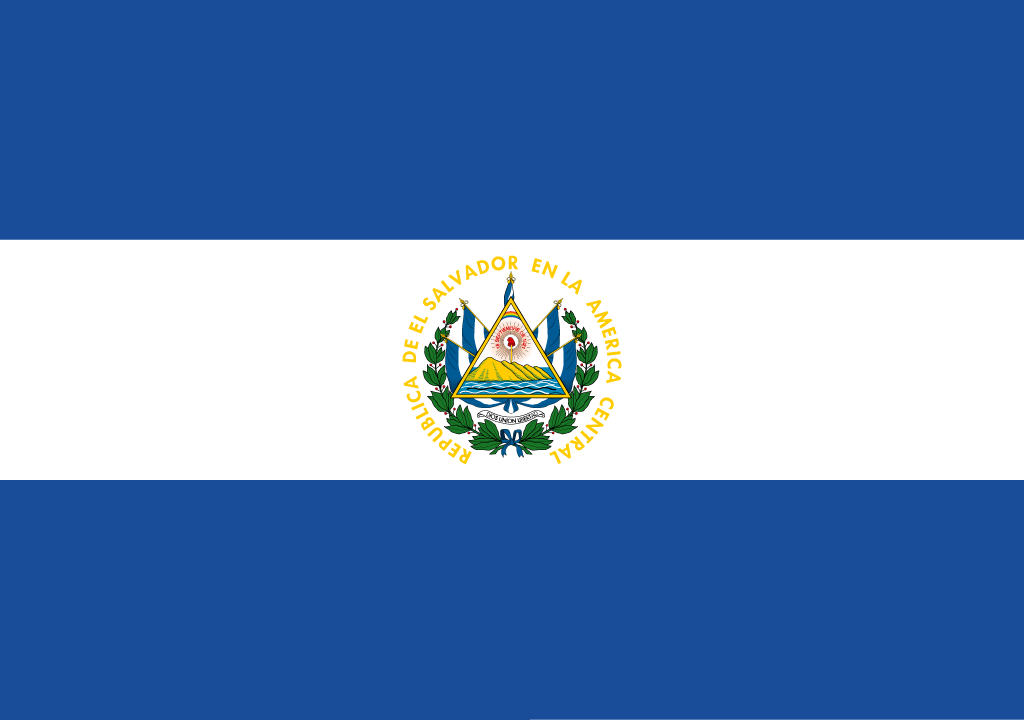
2 colors: blue, white.
Meaning of the flag of El Salvador: Blue represents the Pacific Ocean and the Caribbean Sea; white stands for peace. The coat of arms on El Salvador’s flag is based on the coat of arms of the former United Provinces of Central America. It shows a triangle representing equality and the three branches of El Salvador’s government. Inside the triangle, there are five volcanoes symbolizing the five former members of the federation, flanked by the blue of the ocean and sea. The triangle contains symbols of liberty, ideals of the people and peace, represented by a red cap, golden rays, and the rainbow. This triangle also shows the date that El Salvador gained independence from Spain. Under the triangle, reads El Salvador’s national motto “Dios Union Libertad”, ‘God, Union and Liberty’ in English. The fourteen clusters of leaves represent the 14 departments or states of El Salvador.
Curiosities about the Flag of El Salvador
- The flag of El Salvador has three horizontal stripes, a white one in the middle and two blue. In the center, the national coat of arms: five volcanoes surrounded by water that represent the flag’s name, Tierra de Volcanes Soberbios (Land of Superb Volcanoes).
- The volcanoes are laid inside a small triangle with each vertex symbolizing the country’s master areas: judicial power, administrative power, and legislative power. The coat of arms also includes five flags, one for each of the former provinces of Central America, a red hat that represents the end of slavery, and two laurel branches.
- The blue represents the sky and the Atlantic and Pacific oceans. The white represents peace and camaraderie in the world.
- The colors of the El Salvador flag are common in other nations that were once part of the United Provinces of Central America: Nicaragua, El Salvador, Honduras, Costa Rica, and Guatemala.
- The flag was adopted on 27 May 1912.
Flag of Guatemala
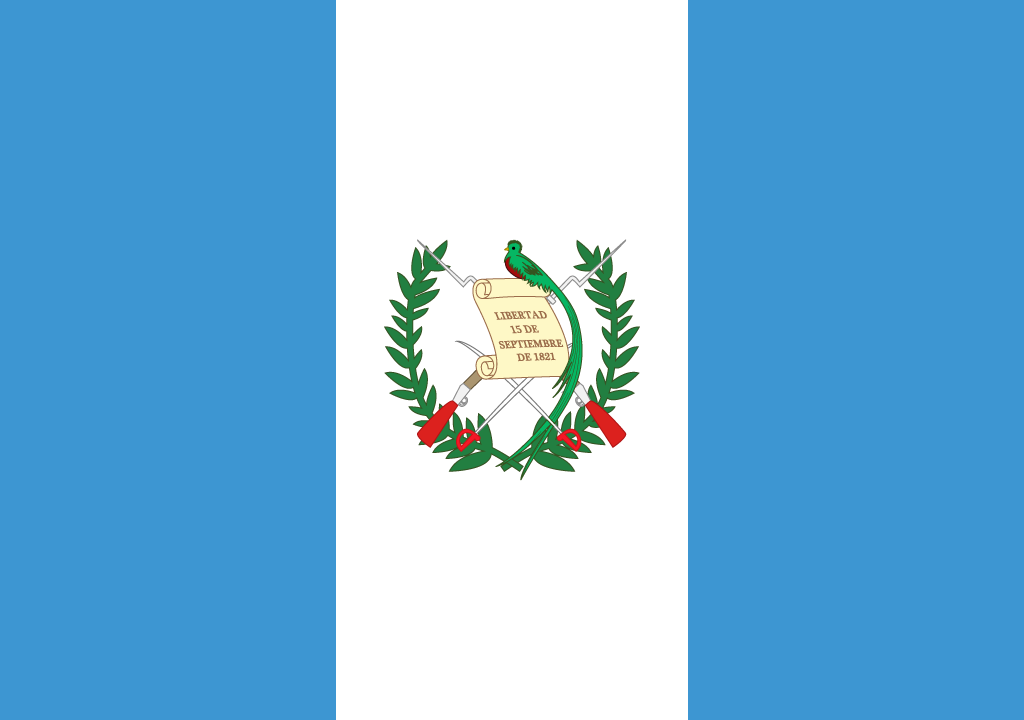
2 colors: blue, white.
Meaning of the flag of Guatemala: Blue refers to Guatemala’s location between the Pacific Ocean and the Atlantic Ocean; white represents peace and the noble virtues of honesty and harmony which are embraced in Guatemala. The coat of arms in the center has a shield with two crossed rifles for the willingness to fight to defend the country against any foreign attack. It also contains two golden swords standing for honor tied to a laurel crown symbolizing victory. The Quetzal bird on the parchment represents the autonomy and independence of Guatemala. Its claws hold a scroll with the date of Central American independence from Spain, December 15, 1821.
Curiosities about the Flag of Guatemala
- The flag of Guatemala has three vertical stripes, one white in the middle and two light blue ones in the edges.
- The country’s coat of arms is placed in the center: two crossed rifles and two crossed swords, with a scroll over them with the motto “Liberdad de 15 de Septiembre 1821“, and a quetzal (a bird) standing in the right end of that scroll, encircled by two laurel branches (a symbol of victory).
- The swords represent honor and the rifles represent the will to defend the country, by force if needed. Fun fact: the Haiti and Mozambique flags are the only two other flags in the world with weapons in addition to the Guatemalan one.
- The white in the flag stands for peace and purity, and the blue represents the two oceans, the Pacific and Atlantic, and the sky. Those are the same primary colors on the flags of the other countries that were once part of the Federal Republic of Central America: Nicaragua, Honduras, El Salvador, and Costa Rica.
- The flag was adopted in 1871 when the country became independent, but the flag as we know it today got its final look in 1968.
Flag of Honduras
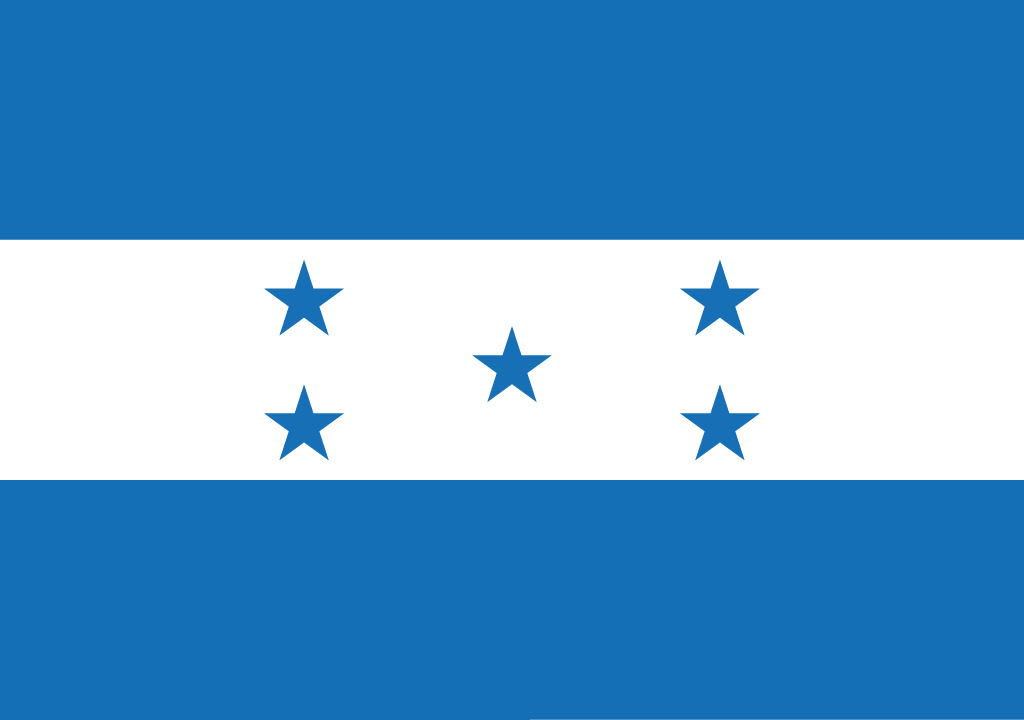
2 colors: blue, white.
Meaning of the flag of Honduras: Blue represents the waters around Honduras, the Pacific Ocean, and the Caribbean Sea; white symbolizes peace and prosperity. The five stars stand for the nations of the former Federal Republic of Central America, which included El Salvador, Costa Rica, Nicaragua, Honduras, and Guatemala.
Curiosities about the Flag of Honduras
- Honduras is one of the countries that were once part of the Federal Republic of Central America. Therefore its flag shares the same colors as the other countries once part of the same political union: blue and white.
- The flag has three horizontal stripes, blue in the top and the bottom and white in the center, with five five-point stars in the middle that represent each one of the five states.
- The blue represents the two vast oceans around Central America, the Pacific, and Atlantic, and the white represents peace and purity.
- The stars, laid in the shape of an X, are a peculiar element, a nod to the times of the Federal Republic of Central America that lasted for 17 years. Honduras was the only country to keep the stars in their flag, which was seen as a sign of the wish to return to a federation-style government.
- The current flag was adopted on 7 March 1866 and, although it went through some changes over the years, the one we see today is the same as the original flag designed.
Flag of Mexico
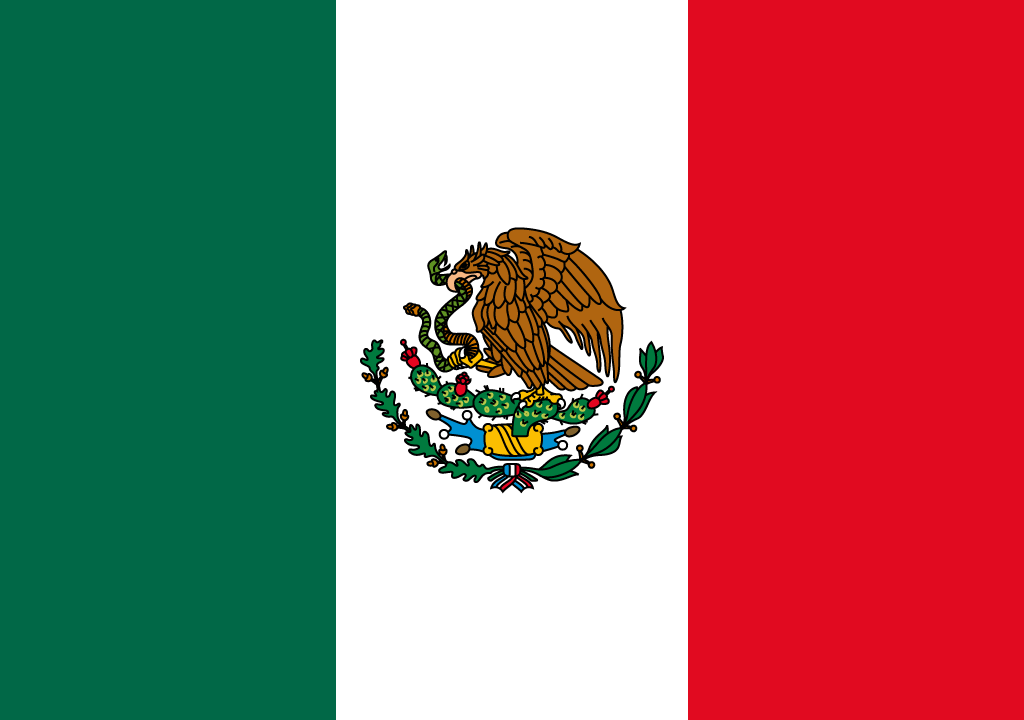
3 colors: green, white, red.
Meaning of the flag of Mexico: Since there is no official explanation to the meaning of the colors used in the Mexican flag, several theories exist. One of them attributes green to Hope and Victory; white to Purity of Ideals; red to the blood shed by the national heroes. Another explains green for Independence; white for Roman Catholicism; red for Union.
Curiosities about the Flag of Mexico
- The flag of Mexico has three colors and three vertical stripes, green, white, and red, from left to right. In the center, the national coat of arms: an eagle subduing a snake with its beak and claws. The bird is on a line of cactuses, and there’s a wreath of intertwined oak and laurel branches underneath.
- That symbol is inspired by an Aztec legend that said the god Huitzilopochtli had told the people to settle wherever they saw him, which happened to be near Lake Texcoco where Tenochtitlan was founded and later became Mexico City.
- As for the colors, the green represents independence, the white represents purity and chastity, and the red represents the blood bond between all the people in Mexico.
- The current flag has a close resemblance with the flag of the First Mexican Empire, designed by Agustin de Iturbide, and adopted in 1821. The flag changed since then, but the basic concept remains the same. The last official revision was made on 16 September 1968.
Flag of Nicaragua
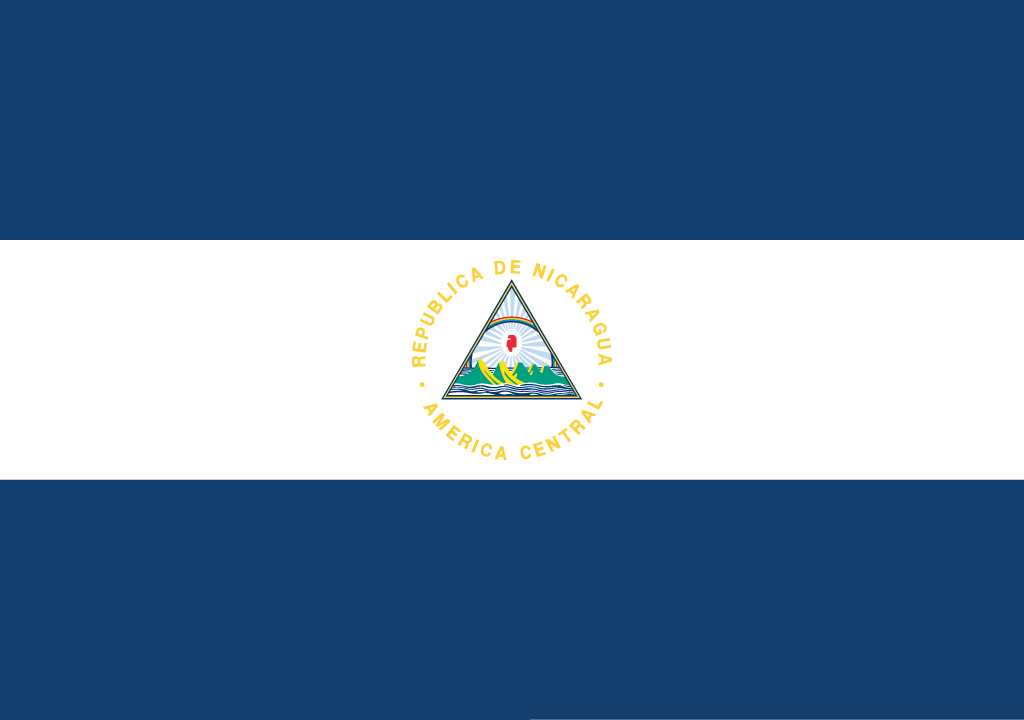
2 colors: blue, white.
Meaning of the flag of Nicaragua: White represents the land between the Pacific Ocean and the Atlantic Ocean, the two masses of water corresponding to the color blue. The coat of arms in the middle of the flag has an equilateral triangle to represent equality. Inside we find five volcanoes between two oceans, symbolizing the original 5 member states (present-day states of Guatemala, El Salvador, Honduras, Nicaragua, and Costa Rica) of The Federal Republic of Central America (United Provinces of Central America) that existed from 1821 to 1841. The Cap of Liberty represents national freedom and the sun rays and the rainbow symbolize the bright future for Nicaragua. Finally, we can read the words “Republica de Nicaragua America Central.”
Curiosities about the Flag of Nicaragua
- Nicaragua is one of the countries that used to be part of the Federal Republic of Central America, and that reflects in the country’s flag, inspired by that extinct political union.
- It has three horizontal stripes, one white in the middle and two blue ones in the top and bottom. The blue represents the two oceans in Central America, the Pacific, and Atlantic, and the white represents purity.
- The triangular national coat of arms is in the center of the flag, with five volcanoes, a number which could be a reference to the number of states that were once part of the Federal Republic of Central America. There’s a rainbow over the volcanoes, with a red hat on top, a symbol of the end of slavery found in many flags.
- Despite the different versions of the flag of Nicaragua over the years, only minor details have changed. In 1908 it was already similar to the current version, which was officially adopted on 27 August 1971.
Flag of Panama
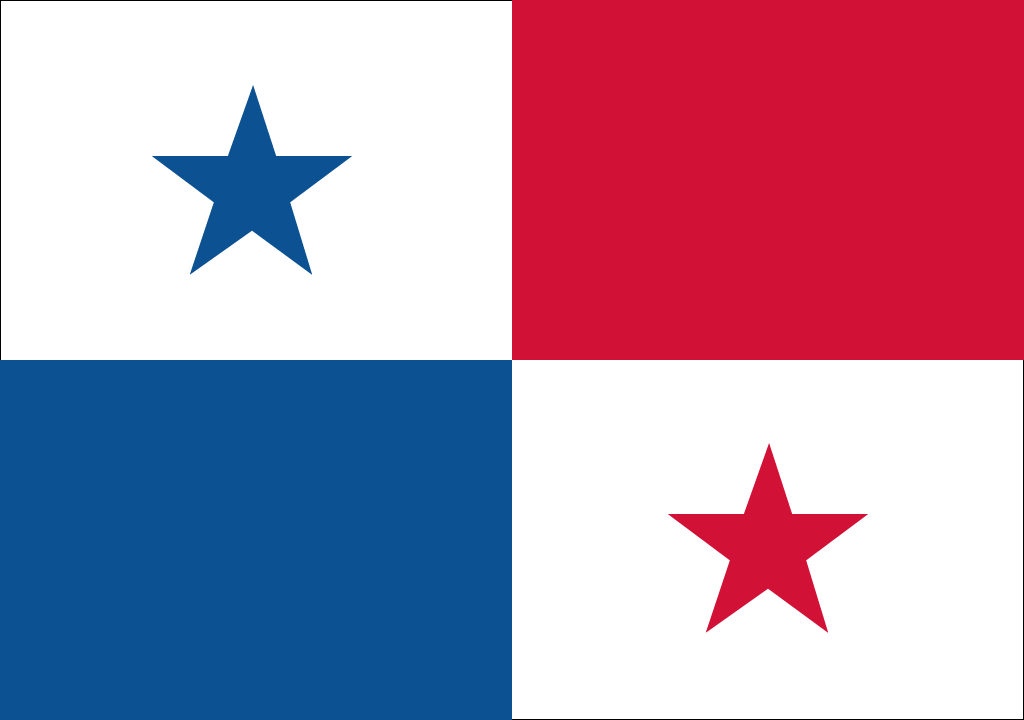
3 colors: blue, white, red.
Meaning of the flag of Panama: Blue and red represent the two major political parties in Panama, the Conservative and Liberal Parties; white stands for peace. The blue star symbolizes purity and the red star is for the new law of the country.
Curiosities about the Flag of Panama
- The flag of Panama is very distinctive, with four separate areas, which are not a common design in national flags. It’s white in the top left and bottom right, and red in the top right and blue in the bottom left. On each white area, there’s a five-point star, blue in the top left corner and red in the bottom right corner.
- It’s a very symmetrical flag, pleasing to the eye, created in 1903 by María de la Ossa de Amador, the wife of then-president Manuel Amador Guerrero, inspired by a drawing by the couple’s son Manuel Encarnación Amador.
- The meaning of the colors is quite practical: the blue represents the Conservative Party and the red symbolizes the Liberal Party. The white represents purity and peace, the red star represents law and order in the country, and the blue star represents honesty.
- The flag was officially adopted on 25 March 1925.
Flags of the Caribbeans
Flag of Antigua and Barbuda
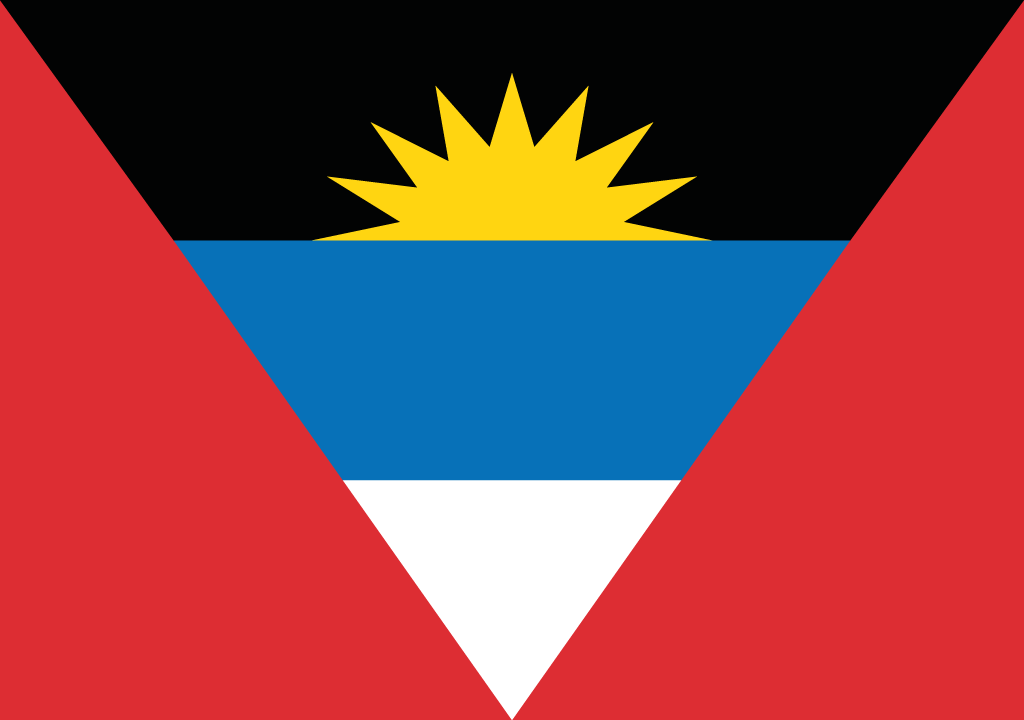
5 colors: red, black, blue, white, yellow.
Meaning of the flag of Antigua and Barbuda: Black represents African ancestry and the soil; blue symbolizes hope; red stands for the strength of the people and the blood of slave forefathers; yellow, blue and white stand for tourist attractions sun, sea, and sand. The 7 point golden sun of the flag represents the dawn of a new era. The “V” formed by the red borders represents: “Victory at last”.
Curiosities about the Flag of Antigua and Barbuda
- The flag of Antigua and Barbuda has a red background with a V shape coming out from the base with several elements: a white section, followed by a blue one from which the sun rises, and a black part on top.
- The red represents energy and the indigenous people, while the black symbolizes the people of African ancestry. Considering the graphic representation, the black might also represent the sky over the sun.
- The sunrise conveys the idea of the birth of a nation and the blue represents hope. This sequence of colors represents the main elements in Antigua and Barbuda: sun, sea, and sand.
- The flag was designed by a local teacher, Reginald Samuels, and adopted in 1967 when the country became independent from the United Kingdom.
Flag of Bahamas
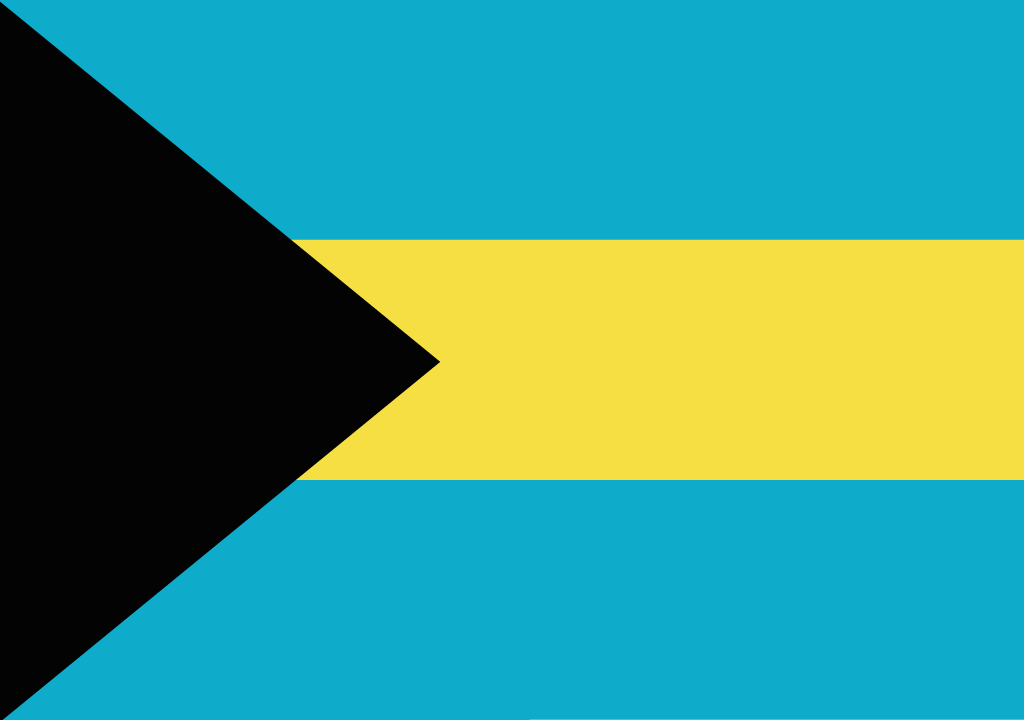
3 colors: blue, yellow, black.
Meaning of the flag of Bahamas: Black represents the power and energy of the common people who have promised to stay united; blue stands for the sea; yellow for the sun. The triangle is for the strength of mind and hard work shown by people of Bahamas.
Curiosities about the Flag of Bahamas
- The flag of the Bahamas has a light blue background, with an almost greenish tone, a yellow stripe in the middle, and a black horizontal triangle on the left, in the shape of an arrow.
- The triangle represents the locals of African ancestry and the energy, strength, and power of the local population, and the blue stands for the Atlantic Ocean around the archipelago. The yellow stripe stands for the sun, sand, and paradisiacal beaches of the Bahamas.
- The flag was designed by Dr. Hervis Bain and adopted on 10 July 1973, the year the Bahamas became independent from the United Kingdom.
Flag of Barbados
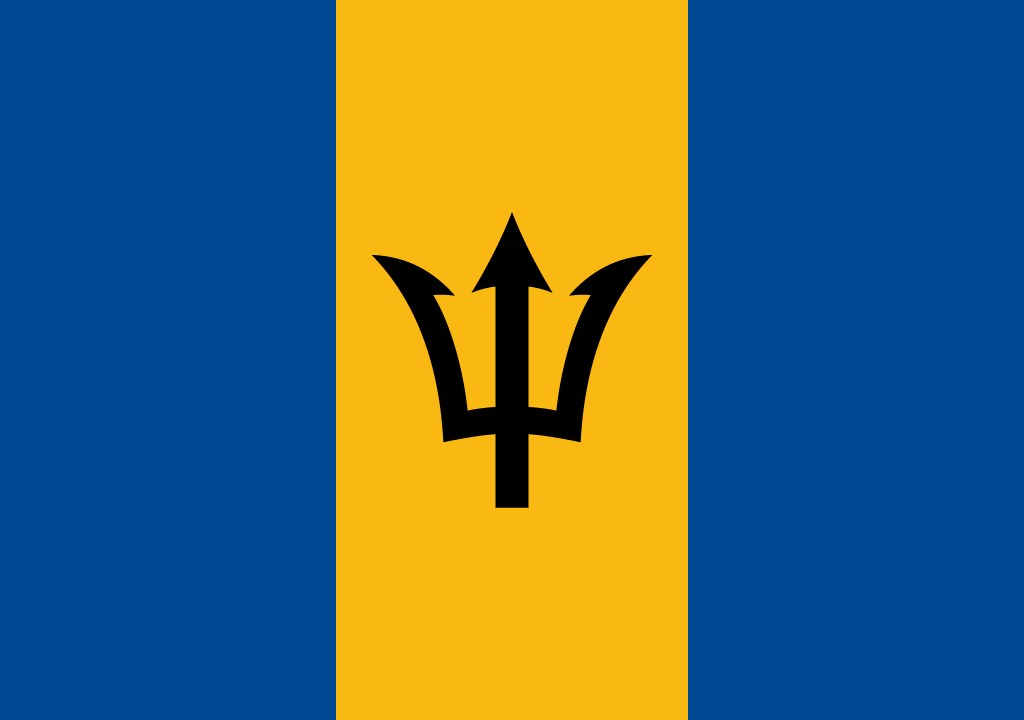
3 colors: blue, yellow, black.
Meaning of the flag of Barbados: Blue represents the sky and the vast sea; yellow stands for the sand and the beaches of Barbados. The black trident with a broken shaft symbolizes Barbados independence from the British, each of the three points representing the three principles of democracy which are the government of, for and by the Barbados people. The Trident is a symbol of the mythical sea god, Neptune, too.
Curiosities about the Flag of Barbados
- The flag of Barbados has three vertical stripes, and the two side ones are dark blue and the center one is yellow. There’s a black trident in the center.
- The blue stripes stand for the sky and the sea around Barbados. The yellow stands for the sand of its beaches. The trident is a heritage from the British era, when Britannia, an Ancient Roman mythological figure, held a trident in her hand.
- The modern flag of Barbados was designed by Grantley W. Prescod, who won a competition out of almost a thousand participants.
- It was hoisted for the first time on 30 November 1966.
Flag of Cuba
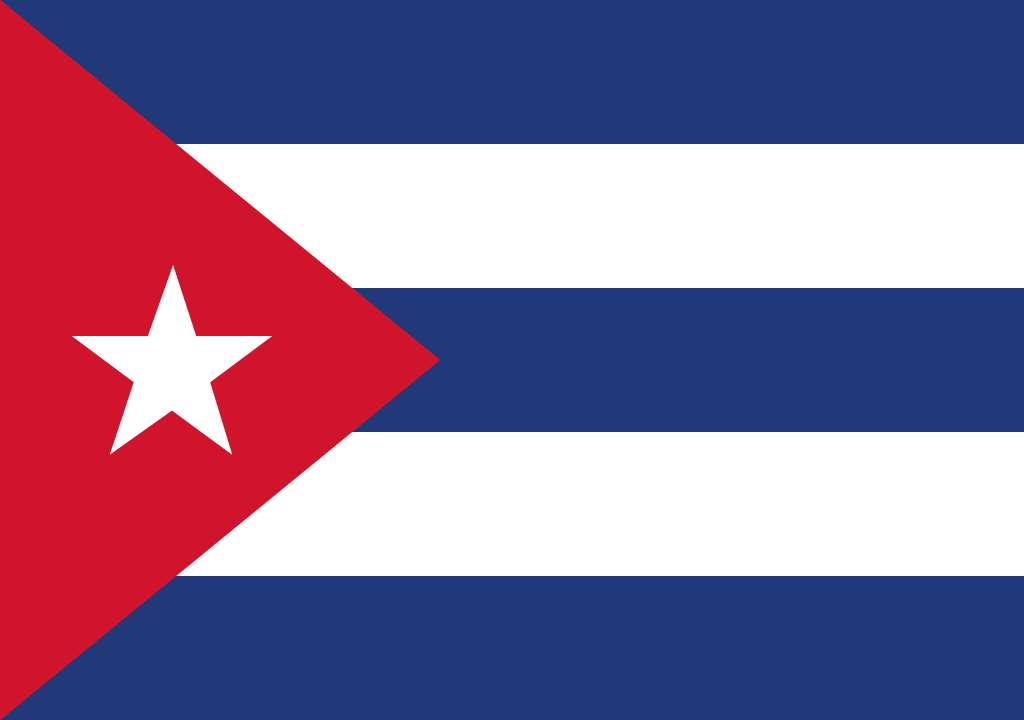
3 colors: blue, white, red.
Meaning of the flag of Cuba: Blue symbolizes the three historic divisions of the island (central, occidental and oriental); white represents the purity of the patriotic cause; red symbolizes the bloodshed in the struggle for independence. The red triangle represents the virtues of equality, liberty, and fraternity. The white star is called La Estrella Solitaria (the Lone Star) and it symbolizes independence and freedom.
Curiosities about the Flag of Cuba
- The flag of Cuba has five horizontal stripes, three dark blue and two white, and a red triangle on the left, laid horizontally like an arrow, with a white five-point star in the center.
- Narciso Lopez designed the flag in 1849, a Venezuelan who was a hero of the fight against Spain and that dreamed of Cuba joining the USA. That’s what precisely the star stands for: that one day that star would join the other stars in the United States of America flag.
- Poet Miguel Teurbe Tolón and José Aniceto Iznaga Borrell, José María Sánchez Iznaga, Cirilo Villaverde and Juan Manuel Macias were also involved in creating the flag. Emilia Teurbe Tolón, the wife of the poet, is believed to have been the person who produced the very first flag.
- The blue stripes represent the three departments of Cuba and the white stripes represent the purity of the independentists’ ideals. The red stands for all the blood those patriots shed. The vertexes of the triangle are thought to represent the three ideals of that fight: freedom, equality, and fraternity, clearly inspired by the French Revolution.
Flag of Dominica
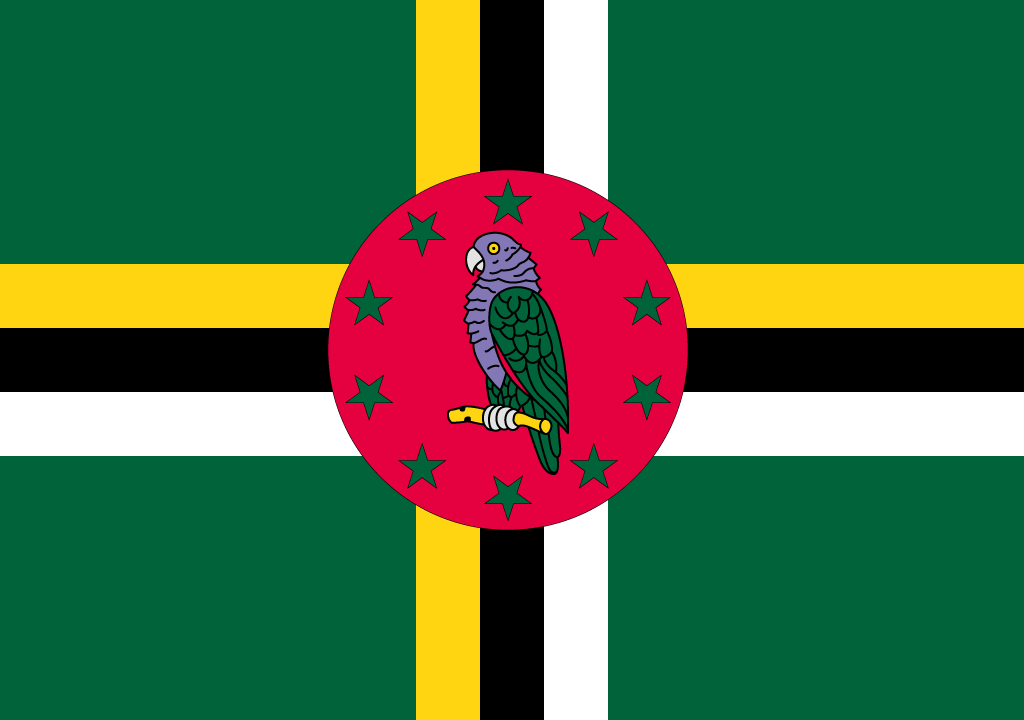
5 colors: green, yellow, white, black, red.
Meaning of the flag of Dominica: The green field represents the lush green forests, the natural beauty, and the rich vegetation of Dominica; white symbolizes the noble aspirations of the people; black stands for the rich black fertile soil; yellow stands for the bright sunshine on the island, the agricultural products of the land (mainly citrus and bananas) and the first inhabitants of the island (the Carib and Arawak people). The national ensign is placed on three vertical and horizontal stripes of yellow, black and white that form a cross representing the Trinity of Christianity, the official religion of the island. The ten green stars represent the ten parishes that form the Commonwealth of Dominica and are also a symbol of hope and the ideals of peace and growth embraced by the Dominicans. The red circular emblem is a symbol of social justice. The parrot in the emblem is the National bird of Dominica, symbolizing the yearning for greater heights and aspirations.
Curiosities about the Flag of Dominica
- The flag of Dominica is green and has a cross overlaid with three different colored stripes: yellow, black, and white. In the center, on a red circle, there’s a purple Sisserou Parrot (a typical bird in Dominica) circled by ten green five-point stars.
- Those stars represent the ten communes on the island, and the yellow represents the country’s people and main productions, bananas and citrus. The black represents the color of the skin of the majority of the population and the island’s volcanic activity, and the white stands for peace and the clear waters around Dominica. The background green represents the primary color of the country’s landscape.
- The flag was created in 1978 by Alwin Bully and adopted shortly after when Dominica became independent.
Flag of Dominican Republic
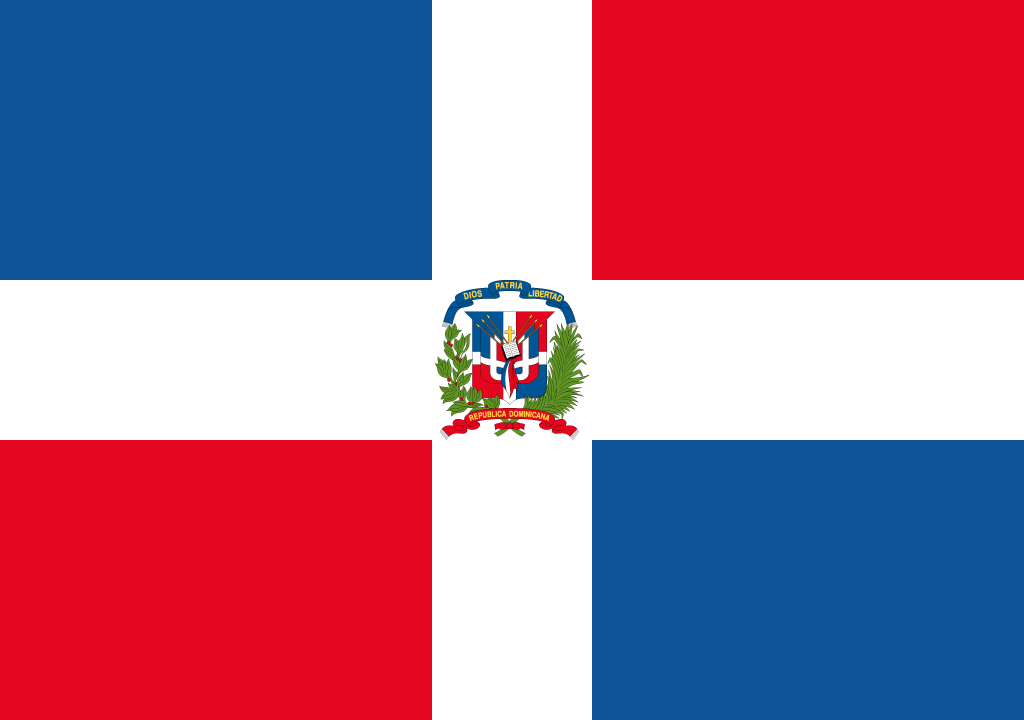
3 colors: white, red, blue.
Meaning of the flag of Dominican Republic: Blue stands for the clear blue skies of the land denoting freedom and liberty; red symbolizes the blood spilled and the noble patriotic spirit of the countrymen in their fight for independence; white stands for peace and dignity. The white cross is symbolic of faith, honor, and pride. The coat of arms has a red, white and blue shield draped by a flag, a Bible, and a cross. The shield contains an olive branch and a palm branch. The blue ribbon above the shield has the words, “Dios, Patria, Libertad”, meaning “God, Fatherland, Liberty”. There is also a ribbon under the shield in red that reads, “Republica Dominicana”, meaning “Dominican Republic”.
Curiosities about the Flag of Dominican Republic
- The flag of the Dominican Republic is split into four sections by a white cross. The colors repeat in opposed corners of each half: dark blue in the top left and bottom right corners, and red in the top right and bottom left corners. A small coat of arms is laid on the center of the white cross: a shield supported by a palm tree and an olive tree branch, with the motto “Dios, Patria, Liberta.”
- As for the colors, the blue stands for freedom, the white stands for salvation, and the red stands for the blood of national heroes.
- The flag was adopted on 21 March 1908 and designed by four women: María Trinidad Sánchez, Concepción Bona, Isabel Sosa, and María de Jesús Pina.
Flag of Grenada
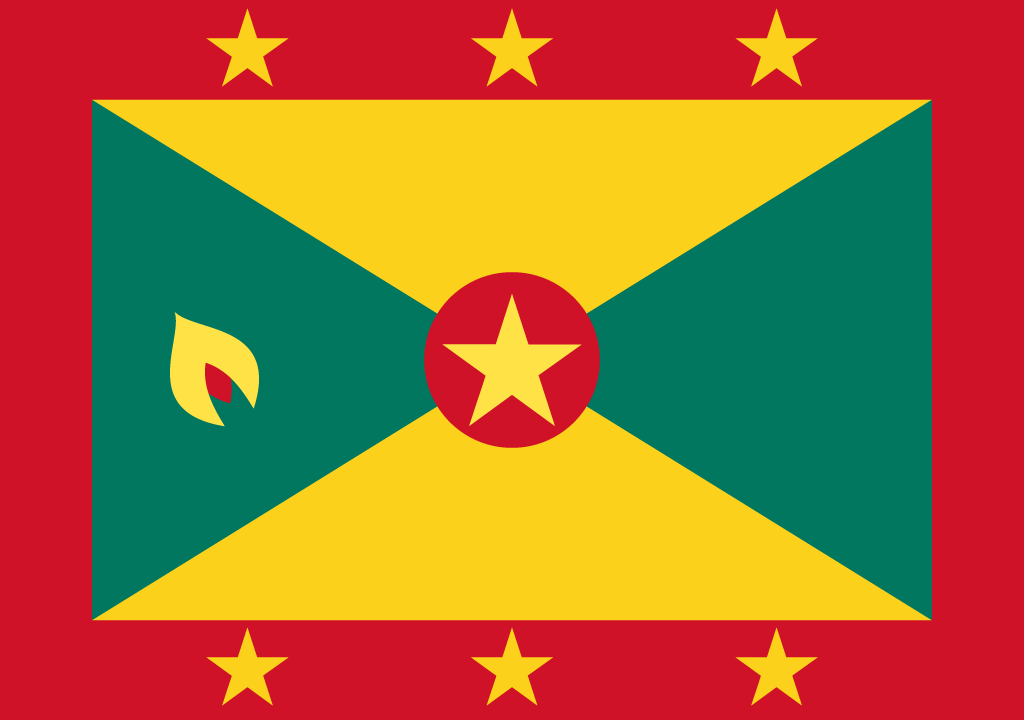
3 colors: red, yellow, green.
Meaning of the flag of Grenada: The colors of the flag of Grenada reflect the country’s ties with Africa and are the typical pan-African colors. Red stands for the courage and vitality of the people of Grenada in their quest for freedom and the red border represents the preservation of their unity; yellow symbolizes sunshine, the warmth of the people and wisdom; green represents the fertile lands. Each of the six stars represents the six parishes and the big star is for the capital of Grenada. The nutmeg portrayed is a symbol of Grenada, formerly known as the Isle of Spice.
Curiosities about the Flag of Grenada
- The flag of Grenada is one of the most colorful and flamboyant flags in the world, and also one of the hardest to describe. It has a red frame all around and three yellow five-point stars in the middle of each red stripe in the top and the bottom.
- In the center, four triangles converge towards the middle: two horizontal green ones and two vertical red ones. In the middle of the flag, there’s a red circle with a larger yellow star. Lastly, on the left side, it has a representation of nutmeg, one of Grenada’s main products. Hence the island’s former name, Spice Island.
- The red represents bravery and strength, the yellow represents the Islanders’ wisdom and warmth, and the green represents the island’s vegetation and agriculture.
- The six stars on the edges of the flag represent the six parishes in the island and the larger one, in the middle, represents Carriacou and Petite Martinique.
- Anthony C. George created this flashy flag and it was adopted officially on 7 February 1974 when the country became independent.
Flag of Haiti
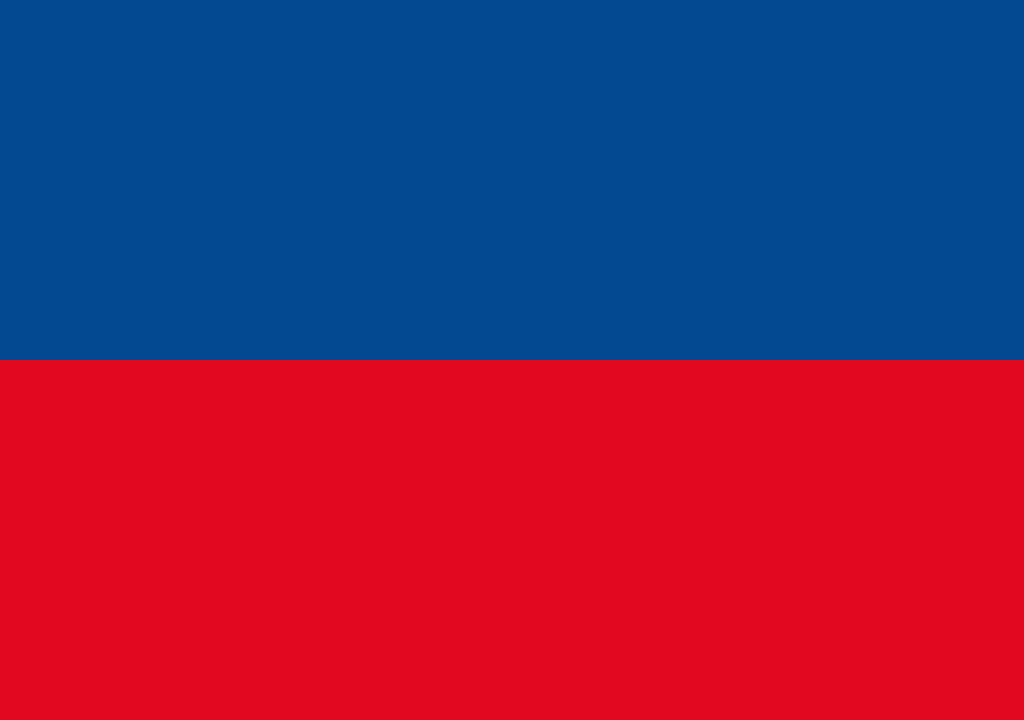
2 colors: blue, red.
Meaning of the flag of Haiti: Since Haiti is a former French colony, its flag uses the colors red and blue. It is believed that the revolutionary Jean-Jacques Dessalines created the flag from the French flag by removing the white center to erase white influence. Blue was left to represent the former slaves and red represented the mulatto population, people of mixed black and white ancestry. The coat of arms has a palm tree with the Phrygian cap, a symbol of liberty. It is surrounded by six Haitian flags. The tree is flanked by cannons. Between them, there are different objects, including a drum, bugles and a broken chain. The banner reads “L’Union Fait La Force”, which means “Unity is Strength.”
Curiosities about the Flag of Haiti
- The flag of Haiti is divided into two horizontal areas, dark blue on top and red on the bottom.
- The coat of arms is inside a small white square in the center: a palm tree with a little red hat on top, encircled by flags with the colors of Haiti, a pair of cannons and smaller weapons. Underneath, you can read the motto L’Union Fait La Force (Unity is Strength).
- The history of this flag dates back to 1803 when revolutionary leader Jean-Jacques Dessalines ripped the French flag to remove the white stripe during the Congress of Arcahaie and asked his goddaughter Catherine Flon to stitch the blue and red stripes together. With the white (symbolizing white people) removed, the blue represented the black people, and the red represented the mixed-race people, united against the French colonial presence.
- Since then, the flag has been through different versions, with black replacing blue several times. In 1849, it looked a lot like the flag we know today. The current flag was adopted in 1859 and only between 1964 and 1986 the country used a different flag, with a black stripe instead of a blue one.
Flag of Jamaica
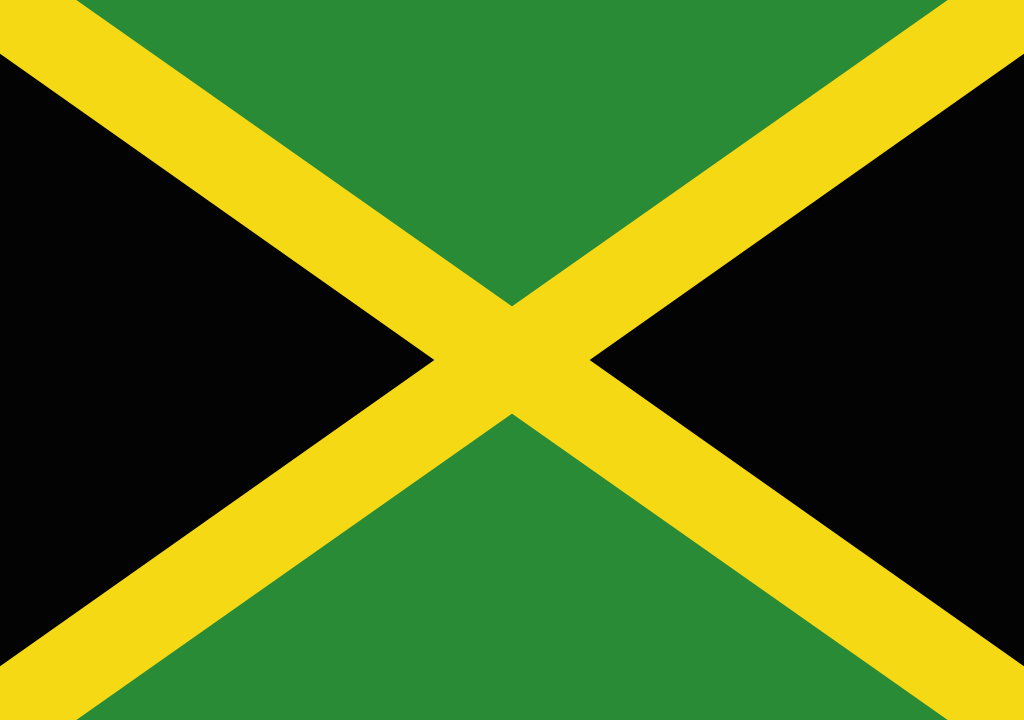
3 colors: green, yellow, black.
Meaning of the flag of Jamaica: The color in the Jamaican flag are all common in African cultures and seen on various African flags, which reflects the country’s African heritage. Green symbolizes hope, agricultural richness, and vegetation; black represents hardships and strength for overcoming those hardships; yellow stands for the sun shining on Jamaica.
Curiosities about the Flag of Jamaica
- The flag of Jamaica has a Saint Andrew cross covering the whole flag and splitting it into four sections: green in the top and bottom, and black in the left and right.
- The symbol of the flag and the colors are officially defined by Jamaica and were inspired by this sentence: “Hardships there are but the land is green and the sun shineth.”
- Based on that, the black represents the strength and creativity of Jamaicans, the yellow represents the country’s natural wealth and sunshine, and the green represents hope, farming, and land in general.
- The use of the Jamaica flag is highly regulated, and it’s forbidden to use the flag for private matters or as a décor item, the kind of things most countries accept as normal.
- The flag was designed in 1962 when Jamaica became independent from the United Kingdom, created by a committee at the House of Representatives that designed several variations.
- Fun fact: the flag of Jamaica is the only one in the world without the colors red, white, or blue.
Flag of Saint Lucia
4 colors: blue, yellow, white, black.
Meaning of the flag of Saint Lucia: Blue represents fidelity, the tropical sky and the surrounding waters of the Caribbean Sea and the Atlantic Ocean. Yellow symbolizes sunshine in the Caribbean and prosperity; black and white stand for the cultural influences of the two races living and working in unity. The isosceles triangle represents the island’s famous twin Pitons at Soufriere, a symbol of the hope and aspirations of the people.
Curiosities about the Flag of Santa Lucia
- The background of the flag of Saint Lucia is light blue, with a set of three consecutive triangles that almost fill the flag from top to bottom. The first one is yellow, the second one is black, and the third one is white, looking almost like the edge of the black triangle.
- The blue represents the ocean, the black, and the white represents the harmony between the different ethnicities that live on the island, and the yellow represents the sun and prosperity.
- The triangles represent the Pitons, two volcanic rock formations that are the country’s national symbol. You can visit the Gros Piton and the Petit Piton on the southwest side of the island.
- The flag was designed by Dunstan St Omer and adopted on 1 March 1967 when Saint Lucia became independent. There were slight changes done in 1979, but the core design is the same.
Flag of Saint Kitts and Nevis
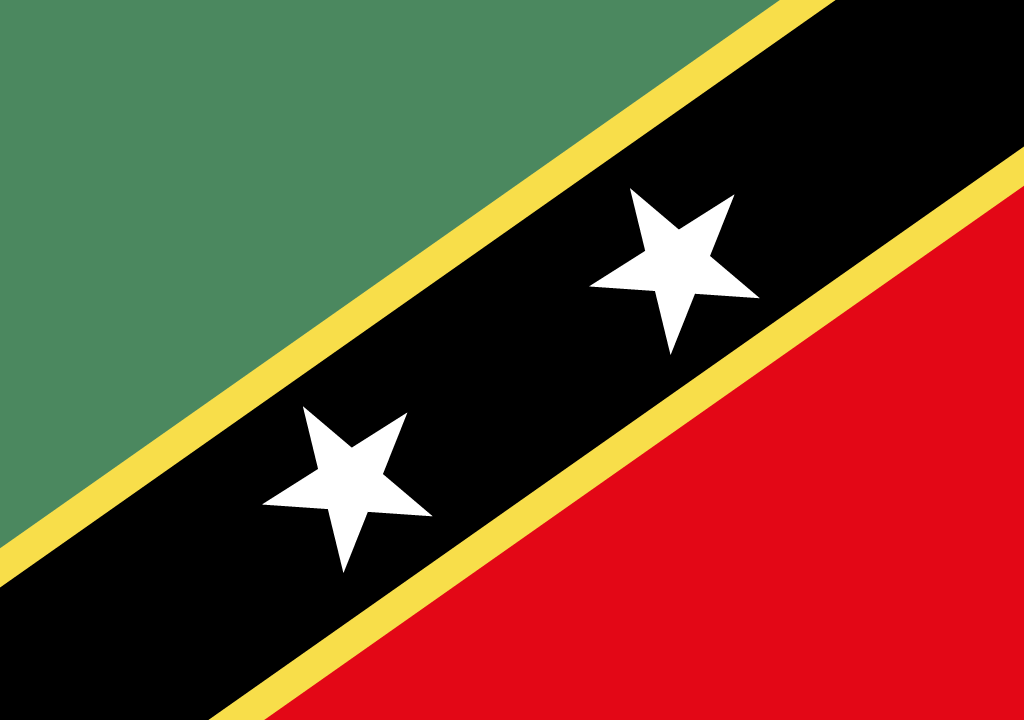
5 colors: green, black, red, white, yellow.
Meaning of the flag of Saint Kitts and Nevis: Black refers to the African tradition of the St. Kitts and Nevis islands; yellow symbolizes the uniform sunbeams in the Caribbean; green stands for agriculture and abundance in the country; red is for the nation’s struggle in overpassing slavery and colonialism and attaining freedom. The stars correspond to represent the independence and optimism of the islands of St. Kitts and Nevis.
Curiosities about the Flag of Saint Kitts and Nevis
- Saint Kitts and Nevis is the smallest country in the Americas.
- The flag of Saint Kitts and Nevis has two diagonal sections, one top green and one bottom red, divided by a diagonal black stripe with two yellow edges across the flag from the top right corner to the bottom left corner. Two white five-point stars are laid over the center of the black band.
- The green represents soil fertility and the primary color of the small country’s landscape, while the red represents the bloodshed by those fighting for freedom and against colonialism. The yellow lines represent the sun that shines brightly for most of the year, and the black represents the African ancestry of the majority of the population. The two stars represent both islands of the archipelago, and also hope and freedom.
- The flag’s symbolism was defined and explained by the flag’s author Edrice Lewis, the young student who won a competition among 258 other candidates.
- The flag was hoisted for the first time on 19 September 1983, the day the country became independent.
Flag of Saint Vincent and the Grenadines
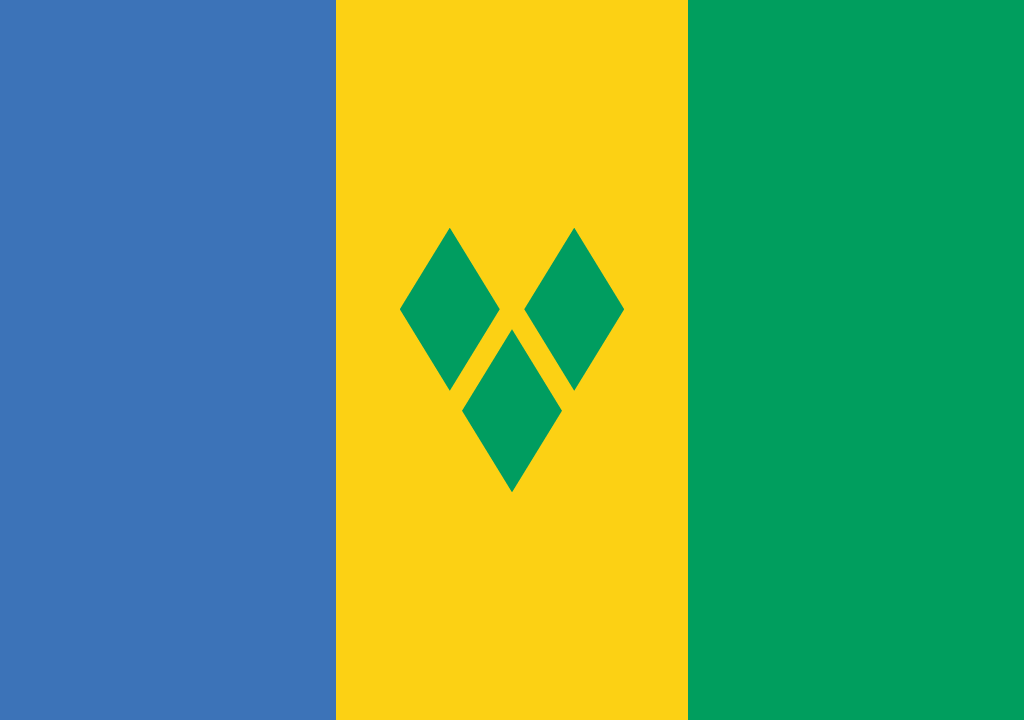
3 colors: blue, yellow, green.
Meaning of the flag of Saint Vincent and the Grenadines: Blue is for the sky; yellow is for the warmth, bright spirit of the inhabitants and the sands of the country; green represents the dense vegetation. The three diamonds are placed in a “V” shape for St. Vincent and intend to represent the fact that the islands are the gems of Antilles.
Curiosities about the Flag of Saint Vincent and the Grenadines
- The flag of Saint Vincent and the Grenadines has three vertical stripes in three colors: blue, yellow, and green, from left to right. The middle stripe is larger than the other two and has three green diamonds in the center shaped like a V.
- The blue represents the sea and the land, the yellow is a reference to the sun, and the green represents the primary color of the islands’ landscape.
- The diamonds represent the islands’ variety.
- The flag of Saint Vincent and the Grenadines was adopted on 21 October 1985, six years after independence from the United Kingdom.

